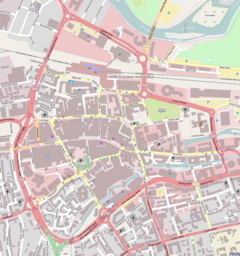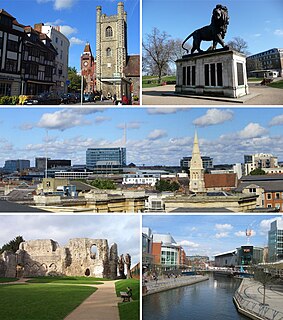
Reading is a historic large market town in Berkshire, England, in the Thames Valley at the confluence of the rivers Thames and Kennet. It is on the Great Western Main Line railway and the M4 motorway, 40 miles (64 km) east of Swindon, 25 miles (40 km) south of Oxford, 40 miles (64 km) west of London, 15 miles (24 km) north of Basingstoke, 13 miles (21 km) southwest of Maidenhead and 15 miles (24 km) east of Newbury. Reading is a major commercial centre, especially for information technology and insurance. It is also a regional retail centre, serving a large area of the Thames Valley, and home to the University of Reading. Every year it hosts the Reading Festival, one of England's biggest music festivals. Among its sports teams are Reading Football Club and Reading Hockey Club, and over 15,000 runners annually compete in the Reading Half Marathon.

Reading Abbey is a large, ruined abbey in the centre of the town of Reading, in the English county of Berkshire. It was founded by Henry I in 1121 "for the salvation of my soul, and the souls of King William, my father, and of King William, my brother, and Queen Maud, my wife, and all my ancestors and successors." In its heyday the abbey was one of Europe's largest royal monasteries. The traditions of the Abbey are continued today by the neighbouring St James's Church, which is partly built using stones of the Abbey ruins.

Kendrick School is a selective girls' grammar school situated in the centre of Reading, Berkshire, UK. In February 2011, Kendrick became an Academy.
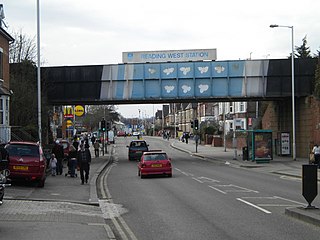
Oxford Road is an urban street and major arterial road in Reading, Berkshire, England, Beginning near the town centre at the meeting of St. Mary's Butts/West Street/Broad Street. The road leads west to Pangbourne, continuing eventually to the city of Oxford. The road was previously known as Pangbourne Lane.
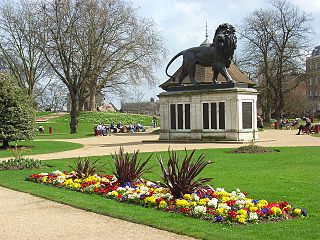
Forbury Gardens is a public park in the town of Reading in the English county of Berkshire. The park is on the site of the outer court of Reading Abbey, which was in front of the Abbey Church. The site was formerly known as the Forbury, and one of the roads flanking the current gardens is still known as The Forbury. Fairs were held on the site three times a year until the 19th century.

Greyfriars Church is an evangelical Anglican church, and former Franciscan friary, in the town centre of Reading in the English county of Berkshire. The church forms part of the Church of England's Diocese of Oxford.

The Hexagon is a multi-purpose theatre and arts venue in Reading, Berkshire, England. Built in 1977 in the shape of an elongated hexagon, the theatre is operated by Reading Borough Council under the name "Reading Arts and Venues" along with South Street Arts Centre and Reading's concert hall.
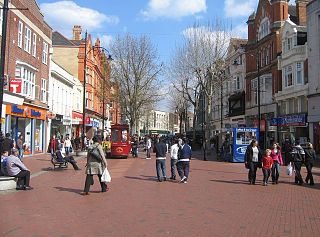
Broad Street is a main pedestrianised thoroughfare and the primary high street in the English town of Reading. The street is situated in the town centre, running for approximately 0.25 miles (0.40 km), from west to east. The western end of the road lies at the crossroads with Oxford Road, West Street and St Mary's Butts. The eastern end continues as King Street after the junction with Minster Street and Butter Market.

Watlington House is a 17th-century building, with a large walled garden, in the town of Reading in the English county of Berkshire. The building is brick built and is reputed to be the oldest surviving secular building in the town. It is a listed building, being listed grade II*. The information on the Historic England website is https://historicengland.org.uk/listing/the-list/list-entry/1321898
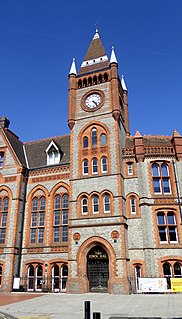
Reading Town Hall is the town hall of Reading, Berkshire, England. The town hall was built in several phases between 1786 and 1897, although the principal facade was designed by Alfred Waterhouse in 1875. Situated close to the site of Reading Abbey, it is adjoined to the north by the Hospitium of St John and to the south by St Laurence's Church.

The Inner Distribution Road or IDR is a mostly dual carriageway ring road that encircles the town centre of Reading, Berkshire, England. It forms part of the A329 that runs from Wentworth in Surrey to Thame in Oxfordshire.

Friar Street is a thoroughfare in the English town of Reading. It runs parallel to Broad Street, connected by Union Street, Queen Victoria Street and Cross Street. At the western end is the Greyfriars Church and at the eastern end are the Town Hall and St Laurence's Church.

Queen Victoria Street is a pedestrianised thoroughfare in the English town of Reading, Berkshire. It connects Broad Street with Friar Street and Station Road.

St Mary's Butts is a thoroughfare in the English town of Reading, Berkshire. On its west side is the Broad Street Mall. It is connected to the north with Broad Street, the pedestrianised primary high street of Reading. St Mary's Church and Butts are where the town of Reading originally grew from.

The Oracle was a workhouse that produced cloth in the English town of Reading, Berkshire. The Oracle shopping centre, which now occupies a small part of the site, takes its name from the Oracle workhouse.

The George Hotel is a hotel and former coaching inn in the town of Reading in the English county of Berkshire. It is situated in the eastern end of the town centre, on the corner of King Street and Minster Street, next to The Oracle shopping mall. It is a Grade II listed building.

The Malmaison Hotel Reading is a grade II listed hotel in the town of Reading in the English county of Berkshire. It is situated at the junction of Blagrave Street and Station Road, directly opposite the main entrance to Reading railway station. It was opened in 1844, shortly after the Great Western Railway opened its line from London, and is thought to be the oldest surviving purpose-built railway hotel in the world.

High Bridge, sometimes known as Duke Street Bridge, is a bridge across the River Kennet in the town centre of Reading in the English county of Berkshire. It links Duke Street, to its north, and London Street, to its south. High Bridge is the oldest surviving bridge across the Kennet, and is a grade II listed building. It comprises a single arch of vermiculated Portland stone, with a plain keystone of ashlar.
Occupation at the site of Reading may date back to the Roman period, possibly as either a trading port on the River Thames, or as an intersection on the Roman road connecting London with Calleva Atrebatum near Silchester.

The Hospitium of St John the Baptist was the hospitium, or dormitory for pilgrims, of Reading Abbey, which today is a large, ruined abbey in the centre of the town of Reading, in the English county of Berkshire. The hospitium was founded in 1189, and at its maximum comprised a range of buildings that could accommodate 400 people. The main building has survived, and is grade II listed. Much of the remainder of the original hospitium was located where Reading Town Hall now stands.

